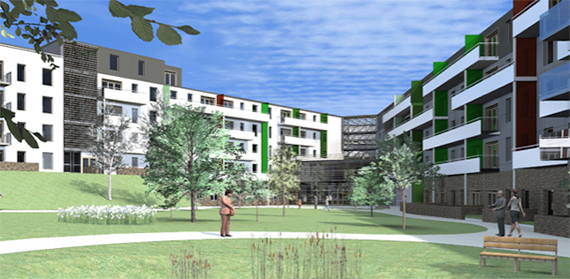Photo: Extra care: Bournville Gardens
By John Woolham, Centre for Communities and Social Justice
Recently the Telegraph published an article titled: ‘Could US-style retirement villages spell the end of the care home?’
Research evidence does suggest that some retirement villages can offer good solutions to the kinds of problems many older people face. However, they are not a panacea. Many of them are designed with owner occupiers in mind – so people sell up their privately owned home to buy a flat (and services) in these communities. This can exclude people who have not been fortunate enough to be able to buy their own home: money not need is the criteria by which flats are allocated. It can also reduce or remove any inheritance to next of kin, but that’s also true of residential care of course.
Also like residential care homes, they can also ‘ghetto-ise’ older people. Actually, this isn’t all bad, by any means. On the one hand, living with people of a similar age (and possibly socio-economic background) can mitigate loneliness and social isolation, (though this if far from certain) and it can reduce the extent to which older residents are subject to anti-social behaviour by younger generations. Some schemes also have a wide range of facilities available on site – everything from hairdressing to yoga which can make it easier for residents to meet up.
However, on the other hand, they can also put up invisible walls and barriers. I recall a research interview several years ago with a couple who moved into a similar scheme who complained that many of their friends no longer came to visit, and those who did seemed to treat them ‘differently’. Some are situated in fairly remote, rural locations. Great if you like good views but disabling if you can no longer drive and the shops or the local pub etc. is a couple of miles away. And they won’t automatically address the problem of loneliness. This will depend, first, on the facilities, second, the nature of the retirement village staff: their number, their skills and the ‘regime’ they are able to create for residents, and third, on the composition of the residents themselves. If they are younger and physically/mentally active then the opportunities for social interaction will be very different from places where a larger proportion of residents are physically or cognitively frail. It might also be worth prospective residents reading the small print: most, but not all of these places will offer a ‘home for life’: so, for example, if you get dementia, require 24 hour care, or start behaving in ways that make other people feel uncomfortable then you (or more likely your relatives) may be invited to consider – ahem – if their mother or father’s needs might not be better met in another establishment. There are also good alternatives – some excellent very sheltered or extra care housing schemes exist which don’t allocate vacancies purely on the basis of ability to pay and which also promote active ageing.
Finally, having been a social care researcher working predominantly with older people for almost 30 years now, I can say that although I am no great fan of residential care, I think public statements by MPs like Paul Burstow are unhelpful – they grab a headline I suppose but are something of a slur on the really good residential care homes run by dedicated and well trained staff. The best of these provide brilliant support and care for many older people.
Photo: HSJ





Comments are disabled